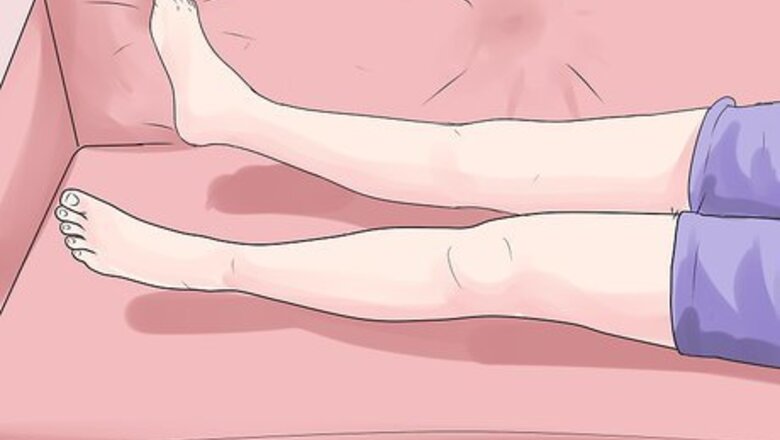
views
Treating a Hematoma
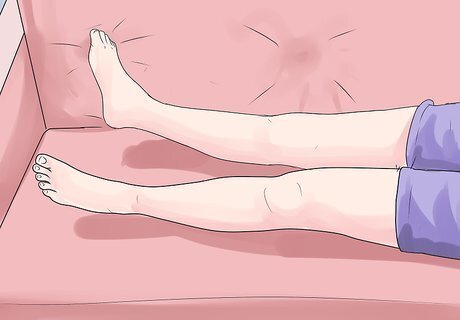
Rest and immobilize the injured part. Muscle activity and movement can irritate and increase the pressure on the soft tissues, which can trigger an inflammatory response and make your hematoma worse. Maintain relative rest for the first 48 hours after injury, if at all possible. Immobilization that keeps you in a normal anatomical position (lying on your back with the palms and feet pointing forward) is helpful in the healing process and may prevent further damage. This is especially true for the extremities and joint areas.

Apply a cold compress immediately after the injury. This should be done immediately and repeated every few hours for 48 hours after injury. Apply an ice pack to the affected area right after you notice a hematoma starting to develop. Low temperature reduces blood flow, decreasing bleeding. Remember not to hold the ice pack on the skin for more than 15-20 minutes to prevent tissue damage. Wrap the ice pack in a cloth to prevent ice burn. The cold temperature causes constriction of the blood vessels and limits post-injury swelling and accumulation of blood underneath the skin. This can also prevent potential tissue damage due to decreased oxygen flow in the injured area.
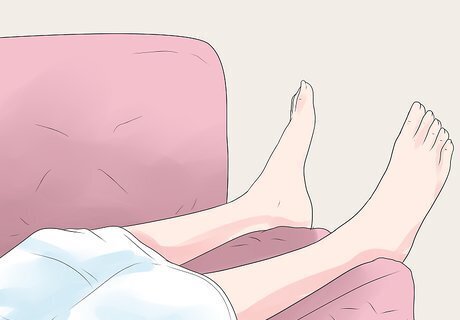
Elevate the site of the injury. This is especially helpful for extremities. Keeping the area in which the hematoma has occurred on an elevated surface will reduce blood flow to that specific area, minimizing swelling and keeping the hematoma from growing. Use pillows or blankets to keep the area elevated. Keep the injured area above the level of the heart, if possible.

Wrap the affected area with a compression bandage to control swelling. Gently wrap an ACE or compression bandage around the injured area. Don't wrap it too tight! You want the bandage to rest firmly against your skin without cutting off circulation, causing tingling, or cutting into the skin. Too much compression can increase swelling around the hematoma and even make the bruising worse.
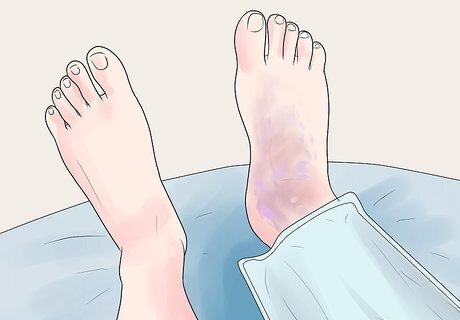
Apply a warm compress after 48 hours. Use a heat pack or a washcloth soaked in warm water. In contrast with the cold compress, warm compresses are more beneficial in the recovery stage, because they dilate the blood vessels and improve circulation and delivery of nutrients necessary for repair. Warning: Do not apply a warm compress immediately after the injury. Increased dilation of the blood vessels will do more harm early on. Also, resist the urge to massage the area, which can slow healing. Much like a warm compress, a relaxing warm bath will also soothe pain and improve circulation in the area. The increased circulation caused by the warmth can help flush waste products from the injury, promoting faster healing. You may also find the warm sensation comforting if your injury is causing a lot of pain.
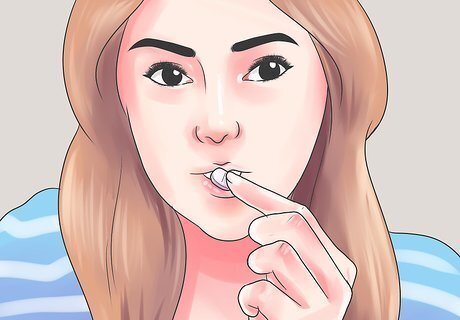
Take pain medication. If you are in pain, take some acetaminophen (Tylenol). Do not take aspirin, as it can prolong your bleeding. Follow the dosage directions on the bottle.
Healing a Hematoma through Diet
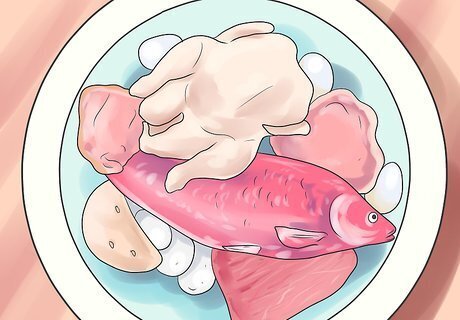
Eat more protein. This may provide needed benefits for tissue repair. High levels of protein usually come from animal sources rather than plant sources. Here are some examples of healthy proteins that may promote healing: Whey protein Tuna Wild salmon Halibut Poached egg Turkey or chicken breast Cottage cheese
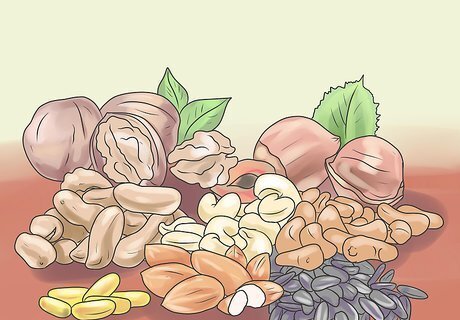
Get enough vitamin B12. A vitamin B12 deficiency can also cause easy bruising. This is especially true for vegetarians—plant food sources have no vitamin B12 unless they are fortified. If you're vegan or vegetarian, ask your doctor or nutritionist if you should take a vitamin B12 supplement. B12 is found naturally in a wide variety of animal foods including organ meats (beef liver), shellfish (clams), meat, poultry, eggs, milk and other dairy foods, some breakfast cereals, and nutritional yeasts.

Consume more vitamin C. Getting enough vitamin C is important for helping your body heal and repair damaged tissues. Great sources of vitamin C include cantaloupe, citrus fruits, berries, watermelon, broccoli, cauliflower, peppers, spinach, squash, tomatoes, and potatoes. As a rule, you can get enough vitamin C by eating a well-balanced diet. Supplements are only prescribed in special circumstances like malnutrition and pregnancy.
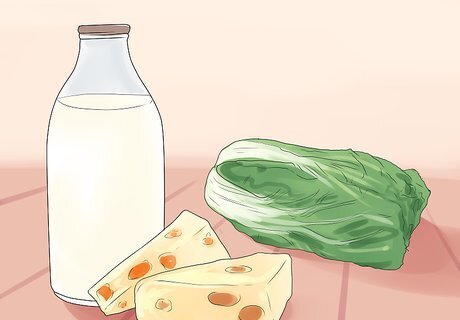
Make sure you get sufficient vitamin K. Vitamin K deficiency is rare in adults. However, if you have it, it can result in impaired blood clotting and other bleeding problems, which can make hematomas worse. Vitamin K deficiency can be caused by medical conditions such as diabetes, celiac disease, and cystic fibrosis. Talk to your doctor if you suspect you may have a vitamin K deficiency. Sources of dietary vitamin K include leafy greens (such as Swiss chard, kale, parsley, and spinach), broccoli, Brussels sprouts, green beans, avocados, and kiwi. Fermented dairy, including yogurt, cheeses, and fermented soy, including miso and natto, are also good sources of vitamin K.

Drink plenty of water. Staying hydrated can improve circulation and help your body heal after an injury. The amount of water that’s best for you will vary depending on your physical activity level, size, and overall health. In general, men should get about 15.5 cups (3.7 liters) a day, and women should drink 11.5 cups (2.7 liters) daily. Water is better than any other liquid you can drink. Unsweetened fruit juices and decaffeinated teas are okay and can be consumed safely in moderation, but the focus should be water. It is possible to drink too much water, so don’t force yourself to drink once your thirst has been quenched. Drinking too much can cause a dangerous electrolyte imbalance.
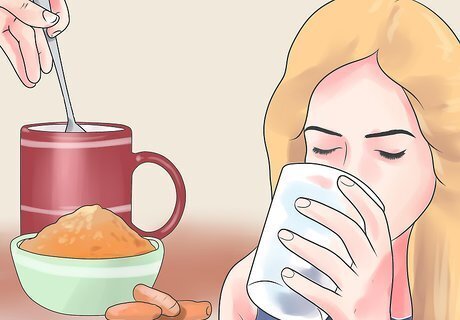
Use turmeric in your cooking. Turmeric is a spice that has long been used in traditional medicine to reduce inflammation and promote wound healing. Consuming turmeric and using a topical curcumin product can help you heal.
Understanding Your Condition
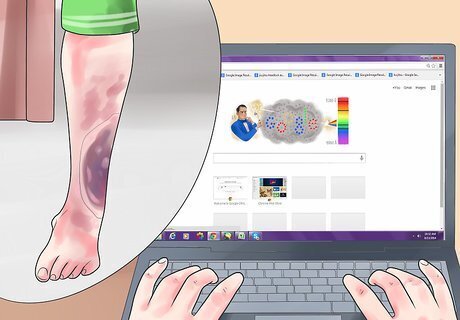
Assess what type of hematoma you have. A hematoma is what happens when blood leaks outside of your blood vessels and pools under the skin or between 2 layers of body tissue. There are numerous types of hematoma, which are called different things depending on where they occur. A few types of hematomas include: Subdermal hematoma (bleeding between the brain and the dura covering the brain) Cephalohematoma (bleeding under the scalp) Subungual hematoma (bleeding underneath a fingernail or toenail)
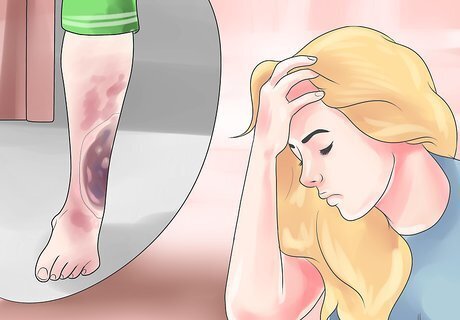
Identify the possible symptoms. Hematoma symptoms depend on the location and size of the hematoma. Here are the symptoms that often accompany your average hematoma: Pain is one of the most common symptoms of a hematoma. It occurs because the tissue where the hematoma occurs is inflamed. If the tissue becomes flooded with blood, it will become inflamed, and will eventually swell. Redness of the area where a hematoma is formed is caused by the blood building up underneath the surface of the skin (subdermal hematoma), and because of inflammation. Severe internal hematomas may cause more serious symptoms, such as headache and confusion, unconsciousness, or weakness in the extremities. If you experience any of these symptoms, seek medical attention immediately.
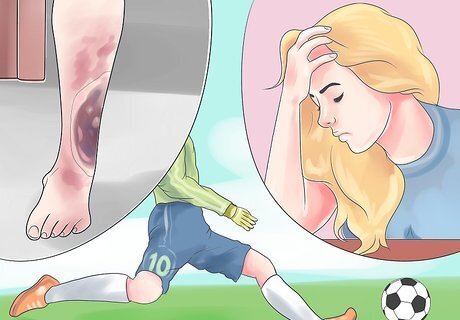
Know the risk factors. One of the main causes of hematoma is trauma. For example, you may be prone to hematomas if you practice a contact sport, such as martial arts, boxing or rugby. However, there are other causes, too. Common risk factors for hematoma include: Bleeding disorders, such as hemophilia and Von Willebrand’s disease. Medications that affect blood coagulation, such as aspirin or warfarin. Deficiencies in certain vitamins, such as vitamin C, B12, or K. Age. Older people have thinner, more delicate skin, putting them at higher risk of developing bruises and hematomas.
When to Seek Medical Attention
Get medical treatment if your hematoma gets worse. A mild or moderate hematoma can be healed by caring for it at home. However, if your hematoma starts to get larger and become more painful, it could mean that there’s a serious issue going on. Get medical treatment to keep the hematoma from getting worse. You may need an X-ray or CT scan to make sure there isn’t a more serious underlying injury. Untreated hematomas can have serious lasting impacts.
See a doctor for any traumatic head injuries. If your hematoma is on your head or neck and is related to an accident or injury, see a doctor to make sure you don’t have a concussion or another serious injury. Untreated head injuries can lead to permanent damage and some may even be fatal. If you are confused, have a headache, feel nauseated or vomit, are drowsy, lose consciousness, or experience mood changes, seek immediate medical attention.
Talk to your doctor if your hematoma doesn’t improve after 1 week. A mild to moderate hematoma is common after an injury and should start to clear up after a day or so. But if your hematoma doesn’t improve at all after 7 days, it could be a sign of a serious injury or a deeper medical issue. Talk to your doctor to see what treatment they recommend. Your doctor may advise you to go to an emergency room or an urgent care clinic to get checked out. There may be prescription medication that your doctor will prescribe to help improve your blood flow to help clear up the hematoma.
Seek medical attention if you have a reaction to any medications. Some people can have adverse reactions to pain medicine or medication prescribed to help treat hematomas. If you start to experience symptoms of an allergic reaction or side effects related to medication that you’re taking, see a doctor to make sure it isn’t serious. Your doctor may prescribe a different medication to reduce your side effects. Symptoms of a serious drug allergic reaction include skin rash, hives, fever, shortness of breath, wheezing, and itchy, watery eyes.














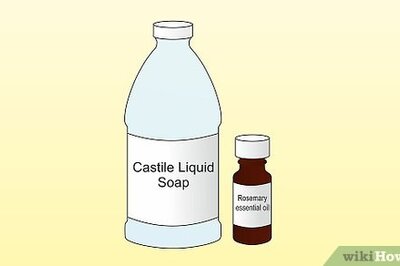




Comments
0 comment